Potato Leafhopper
Imported Cabbage Worm and Diamondback Moth
Colorado Potato Beetle
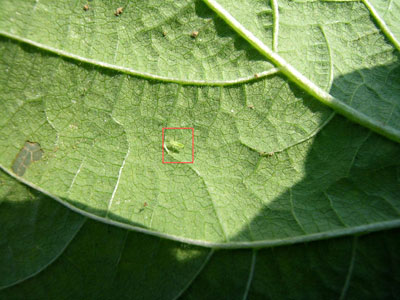 |
| Leafhopper nymph |
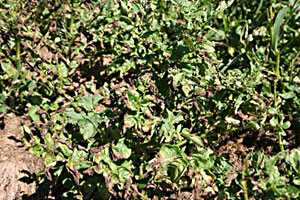 |
| Leafhopper hopperburn on potato leaves |
POTATO LEAFHOPPERS
The potato leafhopper is here and numbers are exploding in some locations. If you see unexplained yellowing of leaves of beans or potatoes, check for the critter.
They primarily feed on beans, potatoes, eggplants, strawberries and alfalfa. PLH does not over winter anywhere near here. They over winter way down south on the coast of the Gulf of Mexico, and leapfrog up here in mass migrations. Sometimes hardly any make it, and other years there are massive numbers. Once they get here there are a few generations during the season and often become a bigger and bigger problem. The first to arrive are females, and they are usually carrying fertilized eggs when they get here. They first land in trees, but quickly search out vegetable crops.
The damage from leafhopper is catastrophic. The bug sucks the juice out of the plant and injects a toxin that clogs the food conducting tissue. The symptoms look like a disease after a while, rather than insect damage, and is frequently mistaken as such. The leaves first get pale, then yellow and then brown from the edges. Then the plant dies. The symptoms are called hopperburn.
The adult PLH is very light green and wedge shaped and tiny (an eighth of an inch long). The best way to find them is to brush the plant, see a bunch of this tiny things fly up, and watch one of the white-looking bugs land. The nymphs are similar to the adult, but have no wings and are even smaller. Nymphs live on the underside of the leaves. If you disturb a nymph you will see it run and it can run sideways as fast as forward. This is a clue that you have PLH and not some other less harmful species of leafhopper.
The adults are flighty. When you brush your crop you will see them fly up. If there is a cloud of them, you are in trouble. Researchers have developed a threshold before treatment is recommended. Thresholds vary but here is one that is typical: Treat potatoes if 5 adults or 15 large larvae are found on 50 leaves.
Crop rotation does nothing for you since they are coming from far away. Covering your crops with a row cover would work, but these crops are not the type that are usually covered. Effective insecticides are limited. The only material that I have seen work that is allowed in organic production is pyrethrum, so Pyganic is the recommendation that I make. Spray in the evening, get good coverage including the undersides of the leaves, and don’t wait until it is too late. If you wait to see leaf symptoms, it is too late. Plants will not recover.
IMPORTED CABBAGE WORM and others
The white butterfly with the dark marks on its wing that are flying in large numbers around the vegetables now is a troubling sight. They are very numerous this year. Becky can find the eggs they lay, and the tiny caterpillars that hatch. I only notice them after I see the holes and chunks chewed out of the leaves. That has not happened yet, but the moths are laying eggs.
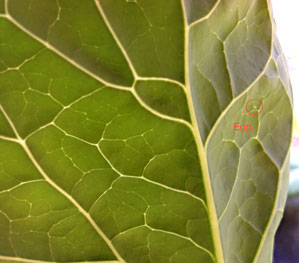 |
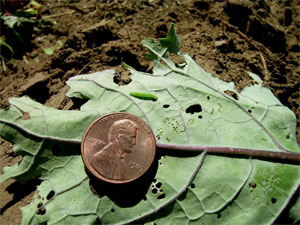 |
| Cabbage worm egg (circled) | Diamondback moth larva |
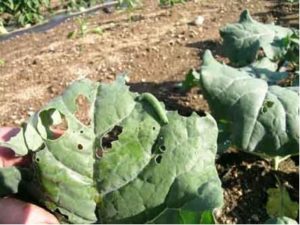 |
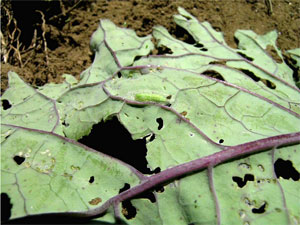 |
| Imported cabbage worm and leaf damage | Diamondback moth pupa |
| Diamondback moth adult | 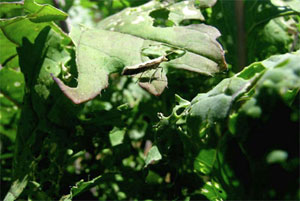 |
The imported cabbage worm is the most common of the three different caterpillars often found feeding on cabbage, broccoli, Brussels sprouts, kale, etc. By the way, it also feeds on lettuce. The pest overwinters as a pupa in crop debris and is a common pest every year.
There are two other caterpillars often seen feeding on brassica crops; the diamondback moth and the cabbage looper. The looper does not overwinter in the north, and I find it the rarest of the brassica pests. Diamondback is being found now. Again, Becky’s amazing eyes found tiny diamondback in the center of cabbage plants yesterday. These pests are carried up here with storms and quickly find crops on which to lay eggs. Hence problems from these two pests vary from year to year. However, since the diamondback is now found earlier in the season then a decade ago, some wonder if they are beginning to winter over here.
All three pests produce multiple generations each growing season. It is important to destroy the crop debris after harvest so as not to harbor future generations that will move onto your later plantings. Controlling cruciferous weeds will help. Row covers will work however these crops do not do well in heat so there could be problems. Netting (e.g. Proteknet) that allows more air movement works well on such cool weather plants.
Bt gives good control of all three caterpillars. Dipel DF is a common brand, and is OMRI listed. As usual, if you are a certified grower be sure that the formulation you use is approved for organic production. Spinosad (e.g., Entrust) works even better, but is more expensive. Be sure to scout the crops and spray only when the pest is present. Bt must be eaten to work and since it degrades quickly in sunlight it should be sprayed only when the pest is actively feeding. There is no protective activity, so there is no point in spraying until you see the caterpillars.
COLORADO POTATO BEETLE
Colorado potato beetles (CPB) adults are starting to show up in potato and eggplant crops. The bright yellow eggs are laid in clumps with about 30-35 eggs each, generally on the undersides of leaves. As with most other insects and plants, there is a direct relationship between higher temperatures (in the range between about 55 and 90 degrees F) and faster rate of development. That includes egg-laying, egg hatch, larval growth, and feeding rates. A period of cold, rainy weather slows everything down, but we can expect a surge of adults and shiny yellow eggs to appear with the next hot spell.
Scouting and Thresholds
Walk your fields NOW and look for CPB adults and eggs. A treatment should be considered for adults when you find 25 beetles per 50 plants and defoliation has reached the 10% level. The spray threshold for small larvae is 4 per plant; for large larvae, 1.5 per plant (or per stalk in midseason), based on a count of 50 plants or stalks.
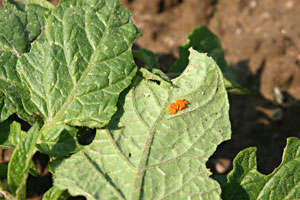 |
| Colorado potato beetle eggs |
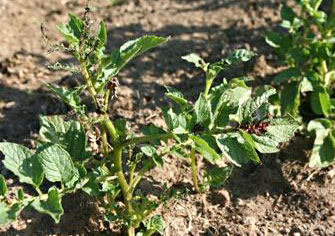 |
| CPB larvae and leaf damage |
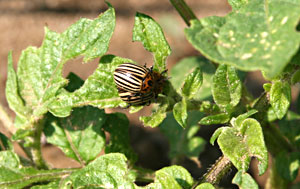 |
| Adult Colorado potato beetles |
Controls are needed on eggplants when there are 2 small or 1 large larvae per plant (if plants are less than six inches) and 4 small larvae or 2 large per plant (if plants are more than six inches).
Potatoes can tolerate 20% defoliation without reduction in yield (or even more late in the season). Damage to eggplant seedlings from adult feeding is often severe enough to warrant control of the adults. In potato, adult damage in rotated fields may not be significant, so you may be able to wait until after egg hatch to kill both late adults and larvae.
Look on the undersides of leaves for the orange-yellow egg masses. The fresher the eggs, the brighter orange the eggs will appear. Eggs hatch in 7-10 days, depending on temperature. If you want to know when the earliest eggs are hatching, you can flag a few of the earliest egg masses you find with bright tape or flags, and then keep an eye on the hatch.
Hatched larvae go through four stages before they become adults. In the first stage, the larvae are about the same size as the eggs and in the second stage they are about an eighth of an inch long. As the larvae get bigger, they do more feeding. The fourth, or largest, stage does 85% of the feeding damage. It’s a good idea to prevent larvae from ever reaching the fourth instar! The smaller instars are the easiest to kill with pesticides.
After larvae complete their growth, they drop to the ground and burrow into the ground to pupate. About ten days, the next generation of adults emerges – ready to feed. If they emerge before August 1, they will lay more eggs. After August 1, they feed and head to overwintering sites. Good control in June prevents problems with CPB in August.
Cultural Controls
Crop Rotation. The single most important tactic for CPB management is to rotate potatoes or eggplant to a field that is at least 200 yards from the previous year’s fields. Since the adult that comes out of winter cannot fly, barriers such as roads, rivers, woodlands, and fields with other crops are helpful. Rotated fields tend to be colonized (from second generation adults that fly well) 1-4 weeks later in the season than non rotated fields. Also, the total population of adult beetles is lower, producing fewer larvae to control.
Perimeter treatments or perimeter trap cropping can be applied to potato. One approach is to plant a barrier crop between overwintering sites and this year’s crop and get it in earlier than the main crop; then control early-arriving beetles.
Early planting. Green sprouting, also know as chitting, prepares whole seed potatoes to emerge rapidly, gaining about 7-10 days to harvest. This early start makes it easier for the crop to put on growth and size before CPB adults and larvae arrive. It can be combined with raised beds and plasticulture. While it won’t avoid damage altogether, it may reduce the need for insecticides. Refer to the New England Vegetable Management Guide (online at www.nevegetable.org) for more details.
Late planting. Another strategy for beating the beetle is to plant late. CPB adults that do not find food leave the field in search of greener pastures. Planting after mid- June, using a short season variety, often avoids CPB damage and eliminates the need for controls.
Straw mulch. It has been well documented that when potato or eggplants are mulched with straw, fewer Colorado potato beetle adults will settle on the plants and fewer eggs will be laid. This can be accomplished on larger plantings by strip planting in a rye mulch, followed by mowing and pushing the rye straw over the plants after they emerge. For smaller plots, straw may be carried in.
Biological control. There are numerous predators and parasitoids that attack CPB adults (a tachinid fly), larvae (12-spotted ladybeetle, spined soldier bug, ground beetles), and eggs.
Organic materials
Spinosad (Entrust) and azadiractin (AZA-Direct) are two options. Studies have shown very good results with spinosad, but please use reluctantly because resistance is building up in populations of CPB. The azadiractin has shown some efficacy, but neem works slowly. Generally it is used to reduce overall damage and reduce numbers but it is not a rescue treatment like spinosad is. Beauvaria bassiana (Mycotrol O) has been shown to suppress CPB populations though does not provide immediate control. And, using Beauvaria bassiana does not jive well with using crop rotation because you need the overwintered adult that remain infected with the fungus to eliminate buying the product new every year.
(Modified from the Umass Vegetable Notes, an article by – R Hazzard; (sources include: D Ferro (UMass Amherst), J. Mishanec (NYS), J Boucher (CT), J. Whalen (DE), T. Kuhar (VA), , G Ghidhu (NJ), New England Vegetable Management Guide, Ohio Vegetable Production Guide)
NOTE: There are label restrictions on the use of Entrust that have been written in to help avoid build up of resistance. Be sure to follow the label with respect to mixing, AND number of times a particular crop may be sprayed per season. The manufacturer sent out a letter a few weeks ago threatening to limit distribution or some other move because they have been getting reports of excessive use. It was disturbing to me that they pointed a finger at organic farmers, but it is good that they are promoting resistance management. Be sure to follow the label and not give the manufacturer any reason to act.
RETURN OF A PROVEN PRODUCT
At long last an acceptable formulation of the organic insecticide Bacillus thuringiensis ssp. tenebrionsis Strain SA-10 (Btt) has come back on the market. Older growers remember a Bt for potato beetle, and remember how it was pulled from the market when Entrust came on. Thankfully, it is back. This will play a large role in deterring resistance build up to both Bt and spinosad.
The “new” product is called Trident, and it is manufactured by Certis USA.
Farmers interested in Trident should call Crop Production Services, who I know is carrying it (795-6640). There may be other dealers in the state as well, and if you find one, please let me know.

